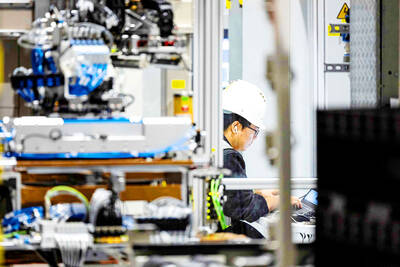The nation’s current-account surplus in the second quarter fell 1 percent from a year earlier to US$17.56 billion, as exports took a hit from a lingering US-China trade dispute and cheaper raw material prices, the central bank said while releasing the latest balance of payment data yesterday.
The figures summarized the nation’s transactions with the rest of the world during the April-to-June period, covering movements of goods, services and income by residents and foreigners.
Exports shrank 2.6 percent in the quarter, while imports rose 0.9 percent on the back of capital equipment purchases by local semiconductor firms in a bid to maintain global technology leadership.
The travel deficit tapered to US$1.03 billion as tourist numbers gained 19 percent, thanks to double-digit percentage growth in visitors from China, Hong Kong, Japan, South Korea and other Asian nations, the central bank said.
Tourist spending picked up 10 percent, especially among Chinese and Japanese, it added.
The trend might reverse after Beijing introduced restrictions on solo travelers to Taiwan ahead of the presidential election in January, although the government’s domestic travel subsidies might help ease the pinch, the bank said.
Daily tourism spending averaged US$191.7 per visitor last year, while Chinese tourists spent an average of US$211.68 per day.
The financial account, which captures fund movements by financial institutions, saw a net capital outflow for the 36th consecutive quarter, signaling that local mutual funds and insurance companies increased holdings in foreign securities, the bank said.
Capital outflows are common in economies with trade surpluses, as financial institutions park surplus liquidity in overseas markets to pursue higher yields, it said.
Foreign portfolio managers cut holdings in local shares by US$290 million on concerns that trade frictions and geopolitical risks are eroding corporate profits.
The local bourse has been relatively resilient and would receive support from capital repatriation, the bank added.

CHIP RACE: Three years of overbroad export controls drove foreign competitors to pursue their own AI chips, and ‘cost US taxpayers billions of dollars,’ Nvidia said China has figured out the US strategy for allowing it to buy Nvidia Corp’s H200s and is rejecting the artificial intelligence (AI) chip in favor of domestically developed semiconductors, White House AI adviser David Sacks said, citing news reports. US President Donald Trump on Monday said that he would allow shipments of Nvidia’s H200 chips to China, part of an administration effort backed by Sacks to challenge Chinese tech champions such as Huawei Technologies Co (華為) by bringing US competition to their home market. On Friday, Sacks signaled that he was uncertain about whether that approach would work. “They’re rejecting our chips,” Sacks

It is challenging to build infrastructure in much of Europe. Constrained budgets and polarized politics tend to undermine long-term projects, forcing officials to react to emergencies rather than plan for the future. Not in Austria. Today, the country is to officially open its Koralmbahn tunnel, the 5.9 billion euro (US$6.9 billion) centerpiece of a groundbreaking new railway that will eventually run from Poland’s Baltic coast to the Adriatic Sea, transforming travel within Austria and positioning the Alpine nation at the forefront of logistics in Europe. “It is Austria’s biggest socio-economic experiment in over a century,” said Eric Kirschner, an economist at Graz-based Joanneum

BUBBLE? Only a handful of companies are seeing rapid revenue growth and higher valuations, and it is not enough to call the AI trend a transformation, an analyst said Artificial intelligence (AI) is entering a more challenging phase next year as companies move beyond experimentation and begin demanding clear financial returns from a technology that has delivered big gains to only a small group of early adopters, PricewaterhouseCoopers (PwC) Taiwan said yesterday. Most organizations have been able to justify AI investments through cost recovery or modest efficiency gains, but few have achieved meaningful revenue growth or long-term competitive advantage, the consultancy said in its 2026 AI Business Predictions report. This growing performance gap is forcing executives to reconsider how AI is deployed across their organizations, it said. “Many companies

France is developing domestic production of electric vehicle (EV) batteries with an eye on industrial independence, but Asian experts are proving key in launching operations. In the Verkor factory outside the northern city of Dunkirk, which was inaugurated on Thursday, foreign specialists, notably from South Korea and Malaysia, are training the local staff. Verkor is the third battery gigafactory to open in northern France in a region that has become known as “Battery Valley.” At the Automotive Energy Supply Corp (AESC) factory near the city of Douai, where production has been under way for several months, Chinese engineers and technicians supervise French recruits. “They